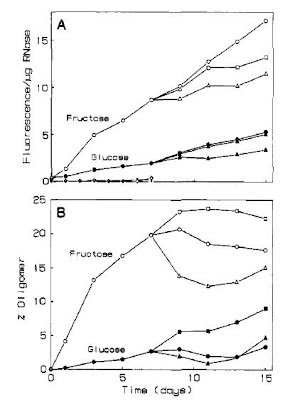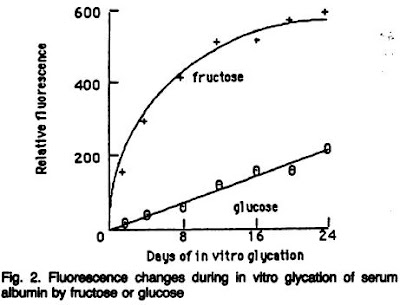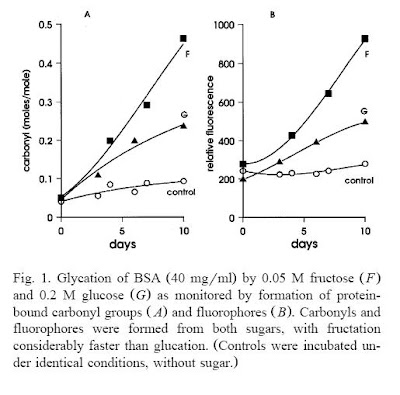The search for answers to the AGE mystery continues. So far, we've seen that even though cooked meat is high advanced glycation endproducts, people who eat meat still have lower levels of AGEs circulating in their body than vegetarians.
One suggested explanation for this is that AGEs produced inside the body (known as endogenous AGEs) are more important than AGEs formed during cooking (known as exogenous AGEs). Specifically, the literature points to fructose being worse than glucose when it comes to AGEs. That could explain how people eating lots of fruit and no meat can still have high levels of AGEs.
It seems to be common knowledge that fructose is ten times more prone to glycation than glucose once inside the body. But is this number correct? To find out, it's time to look at some studies that have actually compared glucose and fructose in terms of endogenous AGEs.
First, a bit of background. Glycosylation is the enzymatic process that links sugars with proteins in a controlled way. Glycation, on the other hand, is the nonenzymatic linking of sugar molecules with proteins in a random way. As the name implies, glycation is the bad boy behind the formation of AGEs.
It was already known in the 1980's that glucose was not the only sugar capable of combining with proteins. Studies had shown that fructose could react with proteins in aqueous solutions and form colored, fluorescent derivatives. What was not clear was whether fructose could react nonenzymatically in mammalian tissues to form random crosslinks the same way glucose does.
The authors of an early study showed that fructation does indeed happen (link). And not only that, but also that fructose can actually cause more crosslinking than glucose:

Graph A above shows fluorescence in bovine ribonuclease from fructose and glucose, while graph B shows crosslinking from fructose and glucose. Fluorescence, which appears to happen after crosslinking and is used as a marker of AGEs, can be readily detected in skin collagen as we age (link). Combined with reduced cell proliferation, it gives aged skin that thin and fragile look. The squares in the graphs show what happened when hexose was removed from the solution, and the triangles show what happened with hexose removed and D-penicillamine added.
Here, the formation of fluorescence is about three times as great for fructose than glucose, but covalent, non-disulfide crosslinking was induced 10 times more rapidly by fructose than by glucose. On the other hand, when the authors tested them in human serum albumin, it was glucose that reacted at 8 times the rate of fructose, for reasons that are not entirely clear.
A paper published one year later concluded that the rate of protein-bound fluorescence generation was 10 times greater with fructose than with glucose (link). The authors also state that fructation converts Amadori products, which are intermediate steps in the whole process, to AGEs faster than glycation. So not only does fructose form more AGEs than glucose, it forms then faster than glucose.
Some of the discrepancies between the results from different papers may have to do with the inaccuracy of methods of measurement. One paper points out that two common glycation assays, serum fructosamine and phenylboronate affinity, would accurately measure only glucose-derived Amadori products (link). These measurements would routinely and misleadingly show glucose to produce 4- to 20-fold more Amadori products than fructose. One reason for this is that Amadori products from glucose and fructose are chemically different; the former is a ketone and the latter is an aldehyde.
The second reason is that, as mentioned earlier, Amadori products from fructose form AGEs faster than those from glucose. Therefore, looking only at the Amadori product step of the process will give the wrong picture, because some of the glycation is still in the Amadori products when fructation has already moved on.
The authors then compared the effects of both fructose and glucose on fluorescence. The authors' analysis shows that fructose is indeed much more prone to glycation than fructose:

At day 8, the difference appears to be about 8-fold. At day 24, it's about 3-fold. As the authors note, this is certainly bad news for diabetics who substitute fructose for glucose, thinking fructose is safe just because it doesn't raise insulin like glucose does. As we've seen here, things are more complicated than what they seem.
Another paper looked at the effect of glucose and fructose on fluorescence and protein-bound carbonyl groups (link). The latter are intermediate products that are featured in the formation of all AGEs. Again, the results show fructose to be much more prone to glycation than glucose:

Note that not only is the fructose graph much higher than the glucose graph, the amount of fructose was only 25% of the amount of glucose used. Exact figures are not reported, but seeing as after ten days, carbonyl formation and fluorescence appear to be a little over twice as great with just one fourth the fructose, fructose would be 8-9 times more effective than glucose. This is consistent with the earlier results.
Another paper states that fructose forms carboxymethyllysine (CML), a type of non-crosslinking AGE, up to 17 times more effectively than glucose (link). CML is a handy marker for AGEs in general, as they can be formed through glycation, fructation or lipid peroxidation, making it possible to compare various sources of AGEs.
To summarize, the claim that the ability of fructose to form AGEs is 10-fold greater than that of glucose does not appear to be too far off. In the case of fluorescence, which happens after AGE formation, the figures in the literature are consistently in the range of 8 to 10. For crosslinking, the 10-fold increase seen with fructose vs. glucose supports this, while for CML, the reactivity of fructose may be even higher.
For more information on AGEs and aging, see these posts:
AGE Content of Foods
Eating Meat or Going Vegan? Comparing AGE Levels in Vegetarians and Omnivores
The 7 Types of Aging Damage That End up Killing You
Yerba Mate Inhibits AGE Formation






